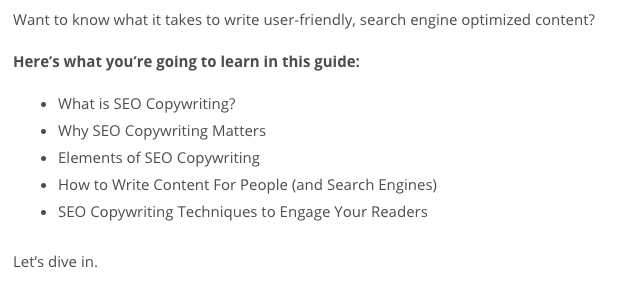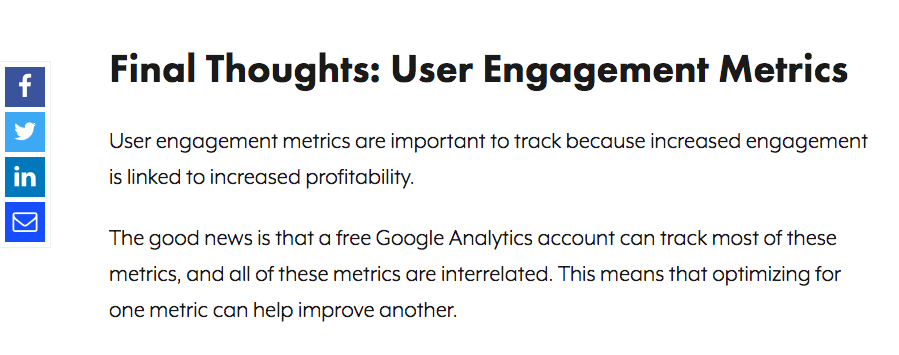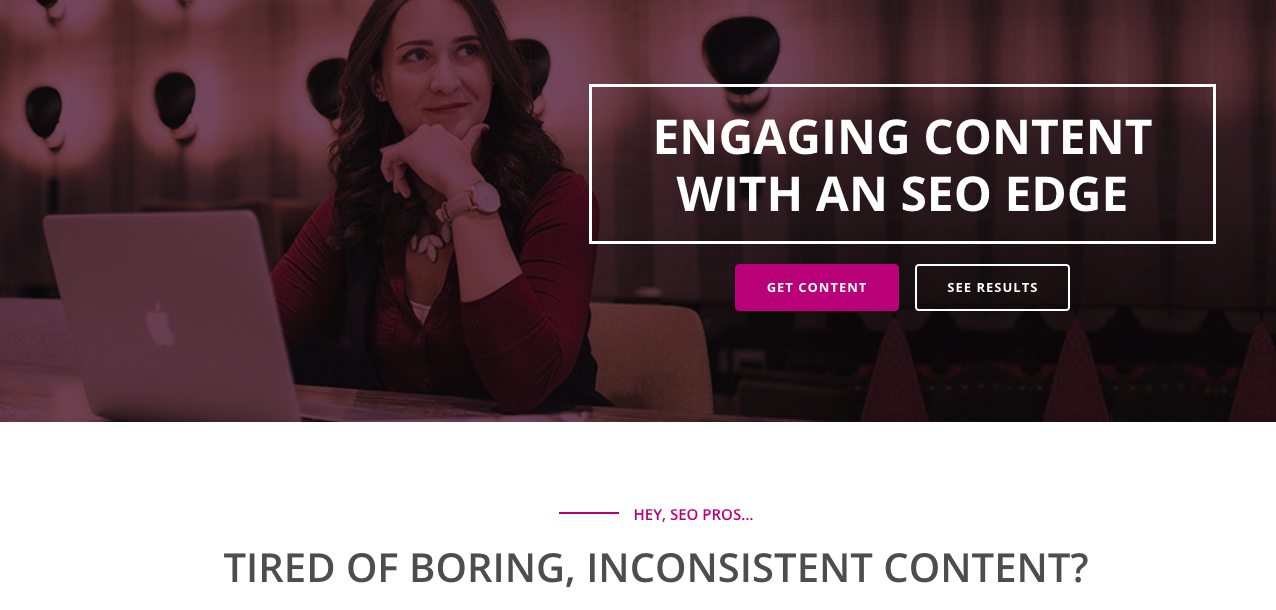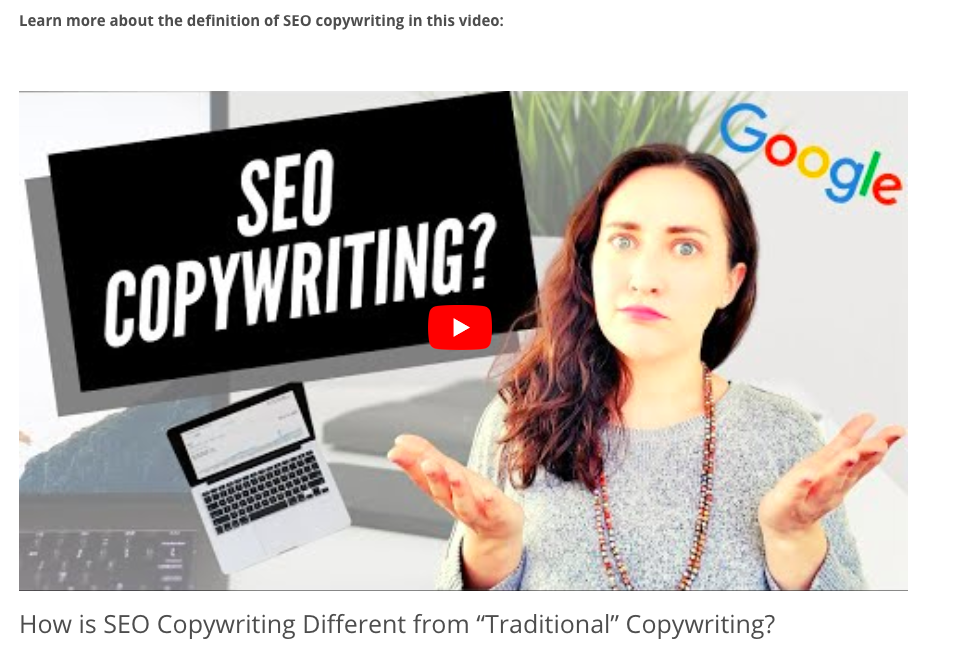The word “engaging” is one that’s thrown around in the SEO space quite a bit, especially when referring to content.
Every SEO professional understands the need to create engaging, SEO-friendly content, but what this actually means isn’t always clear.
Does “engaging” mean driving clicks to a page?
Inspiring social shares?
Getting followers to comment on your posts?
All of the above.
In this post, I’m going to discuss what “engaging” really means and how you can create content that drives the engagement your content deserves.
Defining ‘Engagement’
“Engaging” content is content that entices people to take some kind of action, however broadly defined.
Engagement could be in the form of social media likes, social shares, clicks, form fills, or any other type of action.
Where things get confusing is when marketers herald the need for “engaging” content without defining what action users are expected to take.
This is a problem because it makes it nearly impossible to determine whether one’s content is successful in driving engagement. And most of us know the saying, “What gets measured, gets managed”.
If marketers want to be successful in creating engaging content, they need to first determine what action(s) they want users to take.
With this in mind, they can then craft content that drives users to like/comment/click/share/subscribe.
Measuring Engagement: Engagement KPIs
In the marketing world, key performance indicators (KPIs) are used to measure the success of a campaign.
As with a paid ad campaign, KPIs should be set for your content marketing campaigns as well.
Simply striving for “engagement” won’t pay the bills.
Here are just a few of the many content marketing KPIs that can be used to measure engagement and analyze tangible results:
- Social Media Post Likes: “Likes” on Facebook, Instagram, LinkedIn, and other social platforms tend to indicate that users like your content and therefore can be used as a measure of engagement.
- Social Media Post Comments: Similar to likes, social media comments show that users are interested in your content. Of course, comments can be good, bad, or neutral, so they’re not always a sign of positive engagement.
- Pageviews: Pageviews are a measure of how many users visit a particular page on your website. Pageviews, sessions, and users are the most common website engagement metrics.
- Unique Visitors: A unique visitor refers to a person that visits a website at least once during a particular reporting period. Unique visitors shows how many people your website actually reaches.
- Time on Page: An engagement metric that measures the time a user spends on a page on your website. The assumption is that a user will spend more time on your website if they are interested in your content.
- Bounce Rate: The percentage of visitors that exit after only viewing one page on your website. A low bounce rate is a good sign, as it means users are venturing to other pages on your website.
- Pages per Session: A measure of how many pages a user visits per session. The logic is that if a user visits several pages on your website, they’re likely interested in your content.
- Page/Scroll Depth: If a user scrolls down on a webpage, this could be an indication that they are interested in your content.
- New vs Returning Visitors: You want to get new visitors but you also want users to come back to your site. Great content will encourage visitors to come back time and time again.
- Conversion Rate: Conversions are measured differently depending on your goals. Typically, this involves form fills, purchases, or opt-ins. Your conversion rate is a percentage of how many visitors end up taking a preferred action on your website.
- Cart Abandonment Rate: This refers to the percentage of people who drop off right before they confirm their purchase. If your content is doing its job, you should have low cart abandonment.
This is just the tip of the iceberg when it comes to the different KPIs you can look to when measuring engagement.
The important thing is that you choose the right KPIs based on your goals and look to actual data when determining engagement.
This is the surest way to determine whether your content is yielding the results you want.
Why Create Engaging Content?
It’s one thing to create SEO-friendly content but quite another to create content that converts that organic traffic into paying customers.
While many marketers are focused on keywords, on-page SEO, links, and the like, they often overlook the components that drive engagement and conversions.
Often, creating engaging content is as simple as “writing for the user” (i.e., writing content your target audience actually wants to read).
Ranking content for topics your audience is searching for is nearly pointless if they aren’t finding the value they need and aren’t taking action on your content.
So, creating engaging content – content that entices readers to take action – is essential if you actually want to make money from your content.
Traffic is nice, but conversions are better.
How to Drive Engagement
Once you’ve identified your content KPIs, have a system for measuring progress, and have determined your next content topics, it’s time to craft content that’s sure to drive engagement.
Obviously, results will vary depending on the type of action(s) you want users to take, but the below tried-and-true methods are great for boosting engagement on most content pieces.
In every case, your goal should be to create content your audience will love and that will get them itching to share/like/comment/opt-in/buy.
1. Create a Content Outline
It’s easy to get sucked into the stream-of-consciousness-like process of content writing, but this often leaves your content disjointed and veering off-topic.
Well-thought-out, organized content is best if you want to keep readers engaged and moving toward your main conversion point.
So, before you get to writing, create a basic outline of what you want to cover.
- What questions are your audience expecting you to answer in this content?
- What value are they expecting to find?
- How can you organize this content in a straightforward way?
For example, if I’m writing a guide titled “10 Underrated Marketing Strategies for 2020”, I’m not going to dive right into talking about the #1 strategy.
I’ll probably set the stage with an intro paragraph, provide some stats on how marketing has changed in 2020, and then map out the top 10 strategies.
By mapping out an outline first, you keep yourself focused on your main point and make it easier for readers to skim your content.
If at first glance they see that you cover the information they’re looking for, they’re more likely to read your content from top to bottom.
2. Ask Questions
Asking questions within your blog content and on social media has been shown to increase engagement.
Even though readers may not have an opportunity to actually respond to your question, it will get them thinking and may encourage them to continue reading your content.

For example, if you want readers to continue reading the next section, you might add a question like “What does this mean for business owners in 2020?” or “How can you apply these strategies to your own marketing?”
With these lingering questions in their mind, they’ll be inclined to read on in hopes of discovering the answer.
At the same time, questions at the end of a blog post can encourage blog comments, which you can respond to later.
If you respond to your blog comments, it might encourage users to come back to your site and read more of your content.
3. Add ‘Bucket Brigades’
Bucket brigades are words or phrases that keep readers on your website for longer.
They’re used to break up larger chunks of content and also lead into the next section.
It’s usually a short phrase followed by a colon or ellipses like:
- For example:
- Take this story…
- Interested? Check this out:
- You wouldn’t believe this:
- Here’s one…
- See this case study:
These work beautifully to encourage readers to stay engaged with your content.

In fact, Bucket Brigades are an old copywriting technique that was originally used to keep people reading sales letters.
Today, they are used in SEO content to increase time on page, an important engagement metric.
4. Include Shareable Quotes
Twitter users love to share expert quotes and sound bites from their favorite articles.
That’s why you’ll often see bloggers including block quotes that make it easy for readers to share the quote (and article) to social media, mainly Twitter.
With a single click, users can share your article and have it reach tons of additional users.
In fact, I have seen this in action with my own Search Engine Journal articles, SEJ often embeds a block quote and shares it along with my original article.
This has earned me more Twitter followers, retweets, and Twitter traffic to my website.
Adding block quotes to your articles can be a great way to drive social shares and expand the reach of your content.
5. Add Social Share Buttons
Speaking of social shares… are you making it stupid easy for readers to share your content on social media?
If readers have to jump through hoops (copy your link, paste your link, add an image, add a caption, etc.) just to post an article, you may be hindering your social shares.

That’s why I encourage all sites to include social share buttons and make sure the metadata is filled out.
That means whenever a reader wants to share your article, all they have to do is post the social share button and their post is already propagated with the article’s title, image, and description.
I like to include social share buttons for Facebook, Twitter, LinkedIn, and Pinterest, as these are the top drivers of traffic to my site.
Having these social share buttons has earned me more social media followers and traffic from a variety of social platforms.
6. Offer Content Upgrades
I have a Facebook group for aspiring writers and one of the questions I got today was “My website is getting 500-600 visitors per month. Now what?”
This is a question I see quite a bit, because many writers, marketers, and business owners focus on traffic generation but not on how to capture that traffic.
If you’re not directing visitors to a product, sales, or contact page, you should at least be adding them to your email list via content upgrades.
In response to this writer’s question, I told them to “dangle the carrot”.
In essence, this means offering an irresistible content upgrade that your target audience can’t help but be interested in.
Specifically, offer them content that helps them overcome one or several of their most pressing pain points.
For example, I know that many marketers list “time” as being one of their biggest hindrances in creating SEO content on a regular basis.
To help them overcome this, I might publish a “Time-Saving SEO Content Calendar” that helps them plan out tons of content months in advance.
Then, I’d promote this content in my blog posts and encourage readers to download it in exchange for their email address.
With that, I’m not only providing them with a highly valuable resource, but I am growing my list of email subscribers than I can market to later.
Ask yourself:
Am I giving new website visitors multiple opportunities to engage with my content – or does my marketing strategy end with traffic generation?
7. Add Opt-Ins
While content upgrades do typically involve an opt-in, not all opt-ins involve content upgrades.
You can encourage visitors to opt into anything from your weekly newsletter to a new web tool you just published to a free SEO audit.
The goal, again, is to give visitors at least one opportunity to engage with your content beyond just reading the text on the page.
I encourage website owners to offer multiple opt-in opportunities – typically at the top, middle, and bottom of the page – so visitors encounter several points of engagement.
For example, I direct homepage visitors to my contact page right away where they can apply for SEO content.
Lower down on the page, I include another link to that same application. And at the bottom, I give visitors the chance to subscribe to my newsletter.

With these opt-ins, I can actually measure goal completions rather than just rely on pageview data.
So, I’m able to look beyond traffic and actually measure how many users are engaging with my content.
8. Include Internal Links
If you remember, bounce rate and pages per session were two important engagement metrics.
You can lower your bounce rate and increase pages per session by directing users to other pages on your site via internal links.
There are tons of data about the value of internal linking, but, in a nutshell, the benefits include:
- Directing PageRank from high-authority pages to other pages on your site.
- Directing visitors to other important pages on your site.
- Sending visitors to crucial product and sales pages.
- Keeping readers on your site for longer by directing them to relevant content.
- Preventing “orphan” pages and reducing page depth.
Since the goal is to keep users on your website until they make a purchase or contact you regarding your services, it’s in your best interest to use internal links to direct them to your most important pages.
If you make it easy for users to find the information they’re looking for, they’re less likely to abandon your site and are more likely to convert into a customer.
9. Utilize AI-Powered Product Recommendations
Artificial intelligence (AI) is a relatively new technology but it is powerful in using existing user data to drive engagement and boost sales.
The best application I have seen is in using AI to provide customized product recommendations in order to encourage purchases.
AI-powered tools can analyze user behavior and even your existing CRM data to offer tailored product recommendations to visitors.
That means users are shown products or offers they’re more likely to buy, therefore increasing your conversion rate.
Ecommerce businesses can also benefit from AI-powered predictive sort, which displays different results for each user.
So, if a user is searching for a particular product, they’ll be shown what the AI predicts the user wants to find based on previous shopping behavior.
10. Use Video
Last but certainly not least is the use of video content to increase engagement.
Not only can video drive traffic from Google, YouTube, and other search engines, but it can add value to your text content.
Since videos are easy to view on social, it’s highly shareable and tends to drum up tons of likes and comments.
Brands can create video tutorials, reviews, Q&A videos, and more boost social and blog engagement.

In fact, there are several psychology-backed hacks to create engaging videos your audience will love.
In general, you want to utilize a variety of content types to reach a variety of users and increase engagement on all platforms.
Is Your Content Engaging?
Don’t let your SEO content stop at traffic generation – make sure it drives engagement and results in the conversions your website deserves.
All of this starts with setting your target KPIs and then following best practices to boost these metrics across platforms.
The goal should always be to create content your audience will love and will entice them to take action.
That’s the way to turn passive readers into excited, loyal customers.
More Resources:
- 5 Ways to Use Psychology to Improve Your Content Marketing
- What Is Great Content? The 6 Standards of Content Greatness
- 9 Simple & Fast Ways to Elevate Your Content
Image Credits
All screenshots taken by author, June 2020





